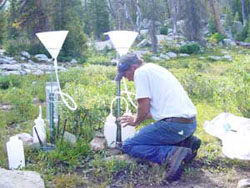AIR | ABOUT US | CONTACT US | FAQ'S | NEWSROOM


![[graphic] Forest Service logo](wo-resources/images/wo-usda.jpg)

| Air Resource Management Home | ||
| Program Spotlight | ||
| PSD Limits | ||
| Who We Are | ||
| Our Partners | ||
| Monitoring and Data | ||
| Air Pollution | ||
| Law and Policy | ||
| Manager's Portal | ||
USDA Forest Service |
||
Wilderness Air Quality Monitoring |
||
 An example of air quality samplers being setup for monitoring. Critical and Target LoadsForest Service air resource specialists are also working to establish critical and target loads for Class I areas to help evaluate adverse effects from air pollution. A critical load can be defined as "a quantitative estimate of the exposure to one or more pollutants below which significant harmful effects on specific sensitive elements of the environment do not occur according to present knowledge". A target load is set based on policy and management direction, and depending on whether or not current critical loads values have been exceeded, a target load can be above or below the critical load. In general, the critical load is based on modeled or measured dose-response data, while target load can be based on political, economic, spatial, or temporal considerations in addition to scientific information. Why Develop Critical and Target Loads?Defining the critical and target loads for areas on the Forest helps resource managers communicate the effects of air pollution on sensitive resources to Forest Service decision-makers as well as to air regulators. This information will also be used to assess how some management activities may exacerbate air pollution related problems or identify areas where mitigation may be an option for resources that have already been negatively affected. This information can be used in a regulatory context when consulting with and advising air regulatory agencies on effects to Forest resources resulting from new and existing sources of air pollution. For more information on critical loads and the related science, please visit the Forest Service Northern Research Station, the EPAs website for Acid Rain or download the USFS Ecological Effects. Related Topics: |
||